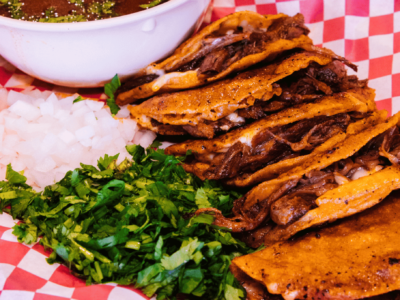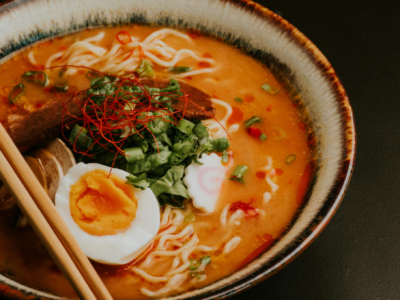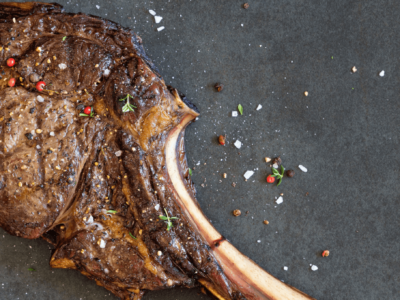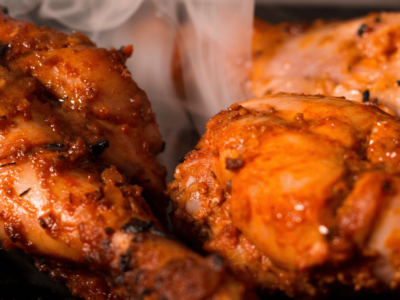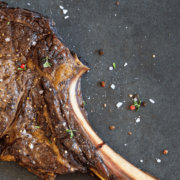Yeah, yeah, we love Kobe beef too – but have you ever thought about the origins of this famous Japanese beef? Have you thought about eating Kobe beef while you are actually in Kobe?
Right at Mt.Rokko’s base, the beautiful port city of Kobe is located – it’s just a 30-minute train journey from Osaka.
Much more subdued than its energetic, no-rules neighbor, Kobbe is a multicultural, quaint town that you must explore on foot for a memorable experience.
And we did exactly that – we set out to explore Kobe on foot.
There was a time when Kobe was serving as Kansai’s major port, and at the time, Kobe maintained plenty of contact with different cultures.
The city happens to be home to Nankinmachi, one of the three largest cities in Japan, founded by Chinese traders and merchants who initially settled there.
Over the years, Kobe has gained popularity across the globe for its beef. While the beef here is undeniably world-class and delectable, Kobe has more to offer than just meat.
So, if you plan to visit Kobe, try out their famous beef. Sandwiched between the sea and mountains, food in this Japanese city witnesses plenty of culinary influence from the surrounding regions, including the Kansai region.
To cut a long story short, the food here is delicious – stay tuned to find out what to eat in Kobe!
Contents
But First, What Makes Kobe Beef So Special?
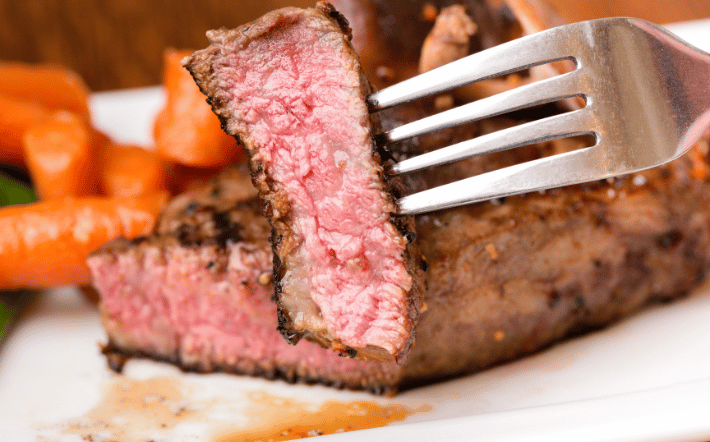
Kobe beef is literally synonymous with some of the best meat in the market. When we reached Kobe, we also heard that people in Kobe massage cows and feed them beer – so that they can live a healthy life before we can eat them.
While that might not be 100% true, it is a fun anecdote anyway! So, what makes Kobe beef special?
Renowned for its world-class quality and melt-in-your-mouth deliciousness, Kobe beef is a highly sought-after and prized delicacy.
People celebrate this meat for its rich, buttery flavor and unparalleled tenderness. It is a sort of delicacy and a staple of Japanese culture and cuisine.
Trust us, people in Kobe know their beef well. But what is it about Kobe beef that makes it so special?
This beef is distinctive and is known to be Japan’s highest-quality beef, produced by Japanese cattle. Moreover, it is not some beef you can randomly purchase from the supermarket.
Let’s check out the qualities that set this beef apart from others – the lesser cuts.
1. Quality Standards:
Beginning with the cattle, Kobe beef is a product of Japanese black cows. To be specific, the Tajima strain of Japan’s Black Cattle. These cows are typically raised in Japan’s Hyogo Prefecture under stringent protocols.
Once the cattle are slaughtered, experts examine these before grading the meat depending on some factors:
- Purebred Lineage.
- Graded A5 or A4.
- Only fed grains and grasses.
- High marbling percentage.
- Weight of 1036 lbs. (470 kg) or less.
2. Marbling And Texture:
Marbling is one of the most crucial parts of actual Kobe beef. In fact, official graders have a particular term, ‘shimofuri fat marbling,’ to determine if a piece is Kobe beef or otherwise.
While most people have the tendency to ignore the fat on top of a steak and call it ‘inedible,’ only a few know that it plays a vital role in cooking. After all, if there is no fat, there is no flavor.
To make things clear, this process dissolves the fat at a relatively low temperature. This means the beef must be cooked well – that way, it is safe from burning. Moreover, it is marbling that enhances a steak to its iconic status.
3. Flavor Distinctions:
Kobe beef is famous for its captivating and distinctive flavor – it is the flavor that sets this beef apart from different kinds of beef. Moreover, Kobe beef’s fine marbling of intramuscular fat happens to be its iconic hallmark.
To make things clear, the marbling contributes to the meat’s rich, buttery texture and exceptional tenderness.
Additionally, the beef’s flavor becomes lean and sweet after its fat is dissolved and caramelized. Also, Kobe beef includes oleic acid, which can impact your taste buds depending solely on the different levels. As a result, if the meat tastes very buttery, then it contains a high percentage of oleic acid.
Did You Know?
It is completely acceptable to season Kobe beef before you can cook it. In Japan, restaurants and locals typically serve beef with soy sauce and salt.
Interestingly, experts do recommend a combination of mild steak seasoning, pepper, and salt. But you should be cautious if you want to avoid going overboard with the seasoning.
The key here is just to allow the meat’s natural flavor to shine, ensuring that it becomes a vital point of your whole culinary experience.
Kobe Weef Vs. Wagyu Beef:

Have you ever heard that “all thumbs are fingers, but not all are thumbs?”
You probably have – the same applies to the whole Kobe Beef and Wagyu Beef. So, while all Kobe beef happens to be Wagyu beef, all Waguy Beef is not Kobe beef – does that make any sense?
The thing is, Wagyu beef refers to a broad category that encompasses multiple cattle breeds, including the ones that were raised in the Kobe region. In contrast, Kobe beef is only a specific subset of the Wagyu category, exclusively hailing from Kobe city.
To make things clearer, Kobe beef costs somewhere between 200 to 500 dollars per pound. Similarly, Wagyu beef costs somewhere between 50 to 150 dollars per pound.
7 Best Dishes with Kobe Beef:
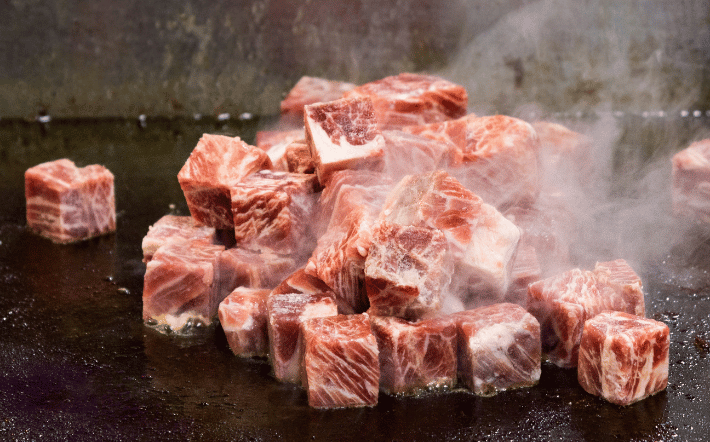
Now that you have a fair idea about the iconic status of Kobe beef, let’s check out the 7 most delectable dishes made with this high-quality beef that you cannot miss out on while you are in Kobe.
- Wagyu Sukiyaki.
- Nikujaga.
- Kobe Beef Steak.
- Shabu-Shabu.
- Sashimi.
- Teppanyaki.
- Kobe Carpaccio.
1. Wagyu Sukiyaki:

We landed in Kobe in search of dishes that were made with the city’s famous beef. Our expectations? To taste how this world-class beef is used in traditional Japanese dishes.
Wagyu sukiyaki was at the top of our list. It is a traditional Japanese dish made with tofu, vegetables, a delicious sukiyaki sauce, and Kobe beef.
Back in the day, restaurants served wagyu sukiyaki with a subtly beaten egg. People used to dip veggies and meat in eggs before eating.
This is used to add a luxurious, silky texture that is surprisingly very addictive. Interestingly, we found restaurants in Kobe that served this dish with thick, chewy udon noodles and a fat base to soak up the savory sauce. Also, if you don’t want to eat this with beef (please don’t!), you can opt for chicken or pork.
After all, Kobe beef is famous for its exceptional tenderness and buttery flavor, thanks to its intramuscular fat marbling.
So, eating the dish with any other protein won’t be the same. Personally, we think that the meat has a deep and delicate flavor profile – it almost has a floral taste.
2. Nikujaga:
Before we could try Nikujaga, we came across its interesting origin story!
Originally, cooks who worked for the Japanese Navy invented Nikujaga – a dish inspired by beef stew. FYI, while ‘Niku’ stands for meat (beef, in this case), and ‘Jaga’ (or Jagaimo) stands for potatoes.
At present, this is one of the most popular dishes to cook at home in Japan. And we understand why – it is simple to cook and even easier to prepare. So, the primary ingredients that you will need to cook nikujaga are potatoes, onions, carrots, and Kobe beef. Since the dish is highly nutritious and can be made easily, it has evolved into a signature dish in modern-day Japan.
In order to make this dish, you will just have to stir-fry all the ingredients together before sweetening the same with mirin, sugar, and soy sauce.
Moreover, there are different theories about the origin of nikujaga. Our favorite theory originates in the historical Meiji Period that lasted between 1868 and 1912.
According to the theory, it seems like the dish was just the result of a failed recipe. Apparently, Heihachirō Togo, the Navy Commander at the time, had requested his chef to prepare beef stew on his warship.
3. Kobe Beef Steak:

There’s no point in talking about Kobe beef and not mentioning the legendary beef steak!
Restaurants in Kobe serve beef with a high rank of A5 and fresh abalone and foie gras at reasonable rates. While you will come across multiple restaurants that serve good steak, we loved places where the chef was grilling the meat and other ingredients at the same time.
If you ask us for our recommendation, then we would recommend the Beef Chateaubriand Steak, one of the rarest A5-ranked beef cuts. It allows you to taste the deliciousness of the steak – both the fat and the lean meat.
You will also be able to enjoy the Japanese savory taste of the umami. So, yum! We also loved how most places that served beef steak in Kobe had so much to offer from the local menu.
Apart from the steak, which is known for its fragrance and refined sweetness, the hugely satisfying meal in most places includes other items that you can select, such as wild Japanese tiger prawn and foie grass.
4. Shabu Shabu:
So, we really liked Shabu Shabu, one of our favorite hot pot dishes of all time. The meat is sliced thinly, cooked in a delicious broth, and then dipped in an even more delectable sauce. Similarly, Kobe beef is a type of Wagyu beef, famous for its soft, delicate texture and fine marbling.
As a result, we decided to try out Kobe beef Shabu Shabu – it was so good because of the fatty Kobe beef!
Moreover, Shabu Shabu made from Kobe beef is a decadent and delicious experience – the rich flavor, the delicate fat, and the tenderness simply melt inside your mouth.
While some people say that the meat is packed with flavors, buttery, and soft, others call it juicy without any toughness.
Additionally, it is almost impossible to replicate the distinctive flavor profile of the meat – it’s deep, beefy, and has a high percentage of fat.
We also enjoyed the nuttiness of the meat, not to mention its subtle sweetness. Kobe beef also includes a high amount of monounsaturated fat, which is good.
Another aspect that we really liked about beef Shabu Shabu is how the broth tasted mild, while the meat was served in bold, dipping sauces.
5. Sashimi:

So, Kobe beef Sashimi – well, this one’s not for everyone. But for beef enthusiasts, it is a delectable appetizer.
For making Sashimi, the beef is cooked just enough for killing the bacteria on the meat’s surface – the meat is eaten cold. So, it’s not entirely raw meat – moreover, lean beef tastes better when it’s raw.
It is delicious, honestly. Plus, Kobe beef is of high quality, flavorful, and tender – it is known for its sweet, lean flavors and rich, buttery texture. We tried out sashimi in more than one place – it tastes subtle, delicate, and amazing!
Since restaurants in Kobe also serve sashimi made from seafood or raw fish, its flavor can change depending on what protein is being used.
But in general, the dish tastes slightly sweet, refreshing, and light. As a result, it is a popular appetizer in Japan.
Additionally, sashimi is good for your health because it can be made with fresh ingredients. Plus, it’s low in calories and is a great source of omega-three fatty acids and protein.
6. Teppanyaki:
First things first – Teppanyaki is not a dish. It’s a style of cooking in Japan – in this Japanese cooking style, chefs use a teppan, that is, a griddle or a flat iron plate. The word ‘yaki’ literally means ‘cooked.’
So, if you love meat like we do, then you will understand how great it feels when a juicy piece of beef melts inside your mouth.
As a result, it is only natural that when you are in Japan, you will try out some of the best meat in the world, a.k.a Kobe beef! While trying out Kobe beef, you should always go to places that serve meat cooked in the Teppanyaki style.
We won’t blame you if you have had beef cooked in this style. We understand that it is very difficult to find anywhere outside of Japan, considering the country’s stringent restrictions on beef exports.
Perhaps only a few restaurants across the world officially serve Kobe beef. Moreover, it is damn expensive.
Just ensure you don’t end up confusing Teppanyaki with Hibachi – remember that the Hibachi style of cooking doesn’t use a flat griddle instead of a standard grill.
7. Kobe Carpaccio:

Last but not least, let’s talk about our final recommendation – Kobe Carpaccio!
So, we have had beef carpaccio in the past – and it has been one of our favorite entrées for a long time now. After all, what’s not to love about beef carpaccio – thin and tender slices of beet fillet served with a delectable dressing, salad, and fresh herbs?
If beef carpaccio is on the menu, then there is a good chance we will order it – yep, that’s how much we love carpaccio.
Naturally, while experimenting with dishes featuring Kobe beef, it was only a matter of time before we wanted to try Kobe carpaccio. And it turned out to be so good!
The perfect start to a meal, we followed it up with Braised Beef Short Ribs, Roasted Autumn Squash Soup, and a side of Truffle Goat Cheese Macaroni. Yes, it cost us more than we expected, but it was worth every slice of juicy Kobe beef – yum, yum!
Also read

